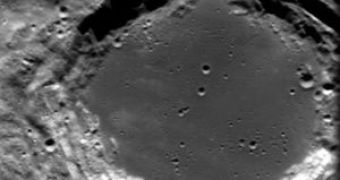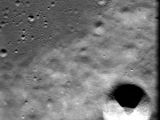This image, taken by the advanced Moon Imaging Experiment (AMIE) on board ESA's SMART-1 spacecraft, shows crater Lomonosov on the Moon's far side.
AMIE obtained the image on 30 January 2006 from a distance of about 2100 kilometers from the surface, with a ground resolution of 190 meters per pixel. The imaged area is centered at a latitude of 27.8? North and a longitude of 98.6? East. Crater Lomonosov is a nice example for a large crater (92 kilometers in diameter) which was filled by lava after the impact, thus exhibiting a flat floor. The terraced walls indicate 'slumping', that is sliding of the rocks downwards due to gravity after the end of the impact. The small craters inside Lomonosov are the result of impacts into this lava floor which happened after the formation of Lomonosov.
Looking closely to the left half of the crater, one can see changes in the brightness of the crater floor, resembling horizontal paint strokes. These can be seen frequently in this area of the Moon and are eject deposits of the young crater Giordano Bruno which is at about 300 kilometers distance.
The crater is named in honor of Mikhail Vassilievitch Lomonossov, a Russian physicist (1711 - 1765). He was professor of physics at Saint Petersburg University and devoted his live to the study of the properties of matter and electricity.
This high-resolution image, taken by the Advanced Moon Imaging Experiment (AMIE) on board ESA's SMART-1 spacecraft, shows the young crater 'Cuvier C' on the Moon.
AMIE obtained this sequence on 18 March 2006 from a distance of 591 kilometers from the surface, with a ground resolution of 53 meters per pixel. The imaged area is centered at a latitude of 50.1? South and a longitude of 11.2? East, with a field of view of 27 km. The North is on the right of the image.
"This image shows the resolving power of the SMART-1 camera to measure the morphology of rims and craters in order to diagnose impact processes", says SMART-1 Project scientist Bernard Foing, "or to establish the statistics of small craters for lunar chronology studies".
Cuvier C, a crater about 10 kilometers across, is visible in the lower right part of the image. Cuvier C is located at the edge of the larger old crater Cuvier, a crater 77 kilometers in diameter. The upper left quadrant of the image contains the smooth floor of Cuvier, only one fourth of which is visible in this image.
Crater Cuvier was named after the creator of the comparative anatomy, Georges Cuvier, a 19th century French naturalist (1769 - 1832).

 14 DAY TRIAL //
14 DAY TRIAL // 
